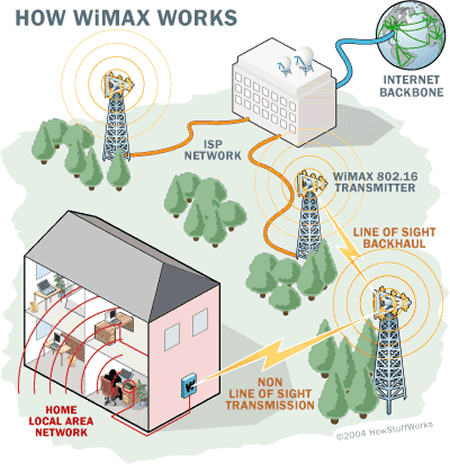While it may sound like some paltry attempt to evangelize another form of Wi-Fi connectivity, WiMax is a substantially different technology that's aiming high. Why is this something to familiarize yourself with? Last week WiMAX was "turned on" for the city of Baltimore, Maryland - and many more cities are on the way. In a nutshell, WiMAX refers to a set of technical specifications detailing a network based on the IEEE 802.16 protocol.
Not to be confused with 802.11 (what you currently know as Wi-Fi), 802.16 is a standard for point to multipoint broadband wireless connectivity. The current revision, 802.16e-2005, has provisions for mobile broadband access, dubbed Mobile WiMAX, such as while in a car at highway speeds. Aside from those details, Mobile WiMAX is a type of 4G network, although this is currently classified as Pre-4G since there is no formal definition of 4G. On an unrelated note, I am looking forward to 4G's inherent IPv6 support. This could usher in another strong push for IPv6 support across all Internet-connected devices and hopefully quench the forthcoming IPv4 address exhaustion.
 A basic diagram showing how Fixed WiMAX works.. but the real benefits come with Mobile WiMAX as well as femtocells.
A basic diagram showing how Fixed WiMAX works.. but the real benefits come with Mobile WiMAX as well as femtocells.
WiMAX suffers from the archaic issue that most wireless technologies subscribe by - the further away you are from the origin, the more bit errors you'll encounter and thus the slower your access will be to maintain acceptable service. Fortunately, the quality-of-service implementation in WiMAX will ensure more efficient data transmission. Also, you're competing for the same connection with other users in your geographical area. Adding more WiMAX towers to the network will allay these issues but that will take time.
In practical terms current WiMAX rollouts, such as Sprint's XOHM service, brings users download speeds of 2-4 Mbps. My first reaction - so what? That's not terribly fast. Hopefully these speeds will ramp up slowly in the next 5 years. The theoretical limitation of WiMAX is around 70 Mbps albeit at very short ranges, so it is more feasible that the end user will see something around 10Mbps with a mature implementation. The release of WiMAX based on 802.16m will boost that number up to 1 Gbps for fixed usage and 100 Mbps for mobile applications, probably not coming to you in 2010-11. Also, WiMAX's line-of-sight limitation is 30 miles and a weak 1-5 miles for not line-of-sight environments. For sufficient coverage of an entire city, it will take a ton of WiMAX towers and subsequently even more backhaul towers to relay the signals from the line-of-sight towers transmitters to the end-user. That doesn't sound easy.
Aside from the technology behind WiMAX, how will this be different than 3G connectivity that many of us use with our laptops? Jason Hiner at ZDNet suggests that the affordable embeddable broadband aspect of WiMAX will be something to keep an eye on.
Embedded WiMAX chips for laptops, for example, are already cheaper than their embedded 3G counterparts. For example, a WiMAX module will typically add about 60-80 to the price of a laptop, while embedded 3G will add 150-200.
But beyond that, these cheap WiMAX chips are poised to be embedded in all kinds of devices, including
- Parking meters
- Home energy meters
- Vending machines
- Toys
- Traffic lights
- Cars and other motor vehicles
I think this will be huge, assuming other WiMAX providers structure their pricing plans after Sprint's XOHM, which boasts contract-free options like a 10 day pass and 35 for on-the-go monthly access. Compare this to AT&T's 3G LaptopConnect cards which require a 60 per month data plan that only accomodates a mere 5GB of included data transfer.
WiMAX: Zero or Hero?
WiMAX has been exorbitantly hyped since the 2001 inception of the WiMAX Forum. It's 2008 and most people think WiMAX is like municipal Wi-Fi on steriods. Beyond consumer confusion, basic WiMAX coverage is at least 2-3 years away for those living in major U.S. cities. Only Sprint and Clearwire are currently backing WiMAX expansion while others are working towards the next hot thing: Long Term Evolution, which from what I can tell, is superior to WiMAX is every way (peak download rates of 326 Mbps) other than not being here yet.
You will keep hearing about WiMAX, especially with Intel's Centrino 2 chipset supporting WiMAX as part of its core functionality. However, I think WiMAX will struggle to make a big dent in technology and will go the way of the dodo RAMbus RDRAM.
I'll leave you with this quote from a Venture Beat article summarizing the CTIA 2008 wireless conference:
One CEO of a WiMax operator in Australia said the technology “failed miserably” with latencies (delays) as high as 1000 ms only 400m away from a cell site, and “non-existent” non-line-of-sight reception beyond a mile away. They had to switch back to TD-CDMA just to ensure their customers got a dial tone.
What do you think about mobile broadband initiatives like WiMAX? Do you have a need for mobile broadband or are you fine with your Wi-Fi AP at home, at the university/work and at the occasional coffee shop?